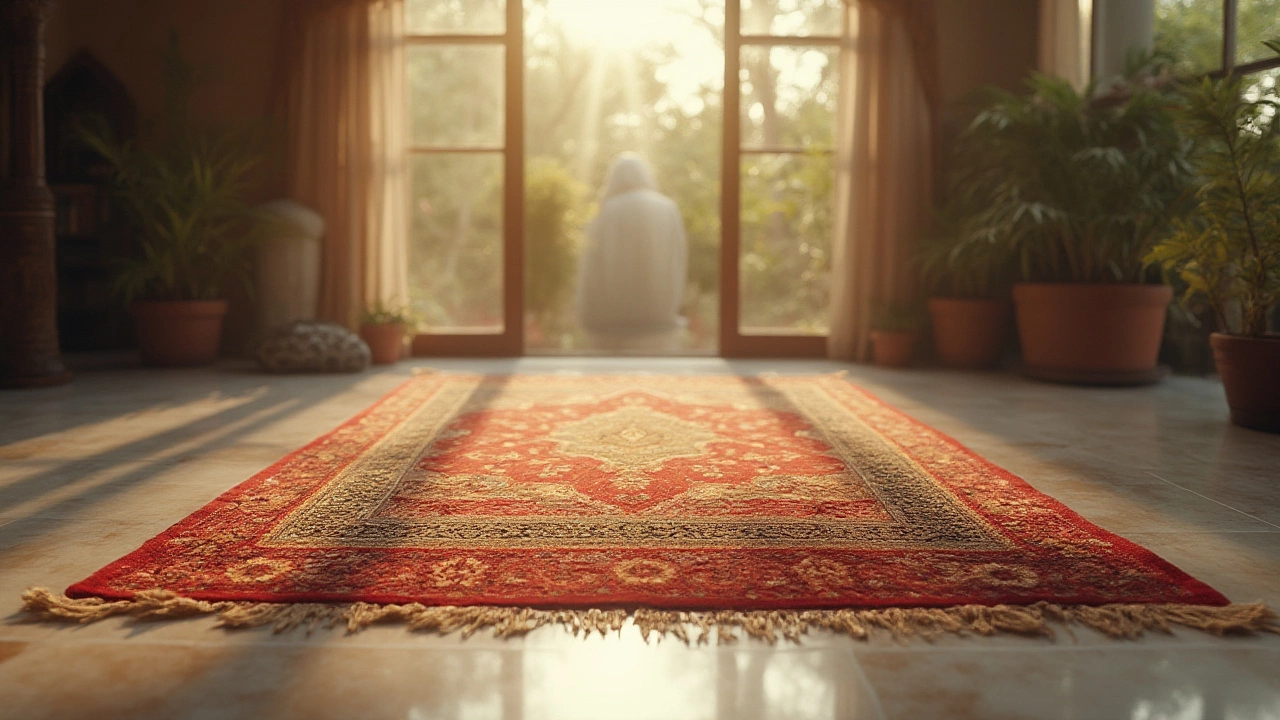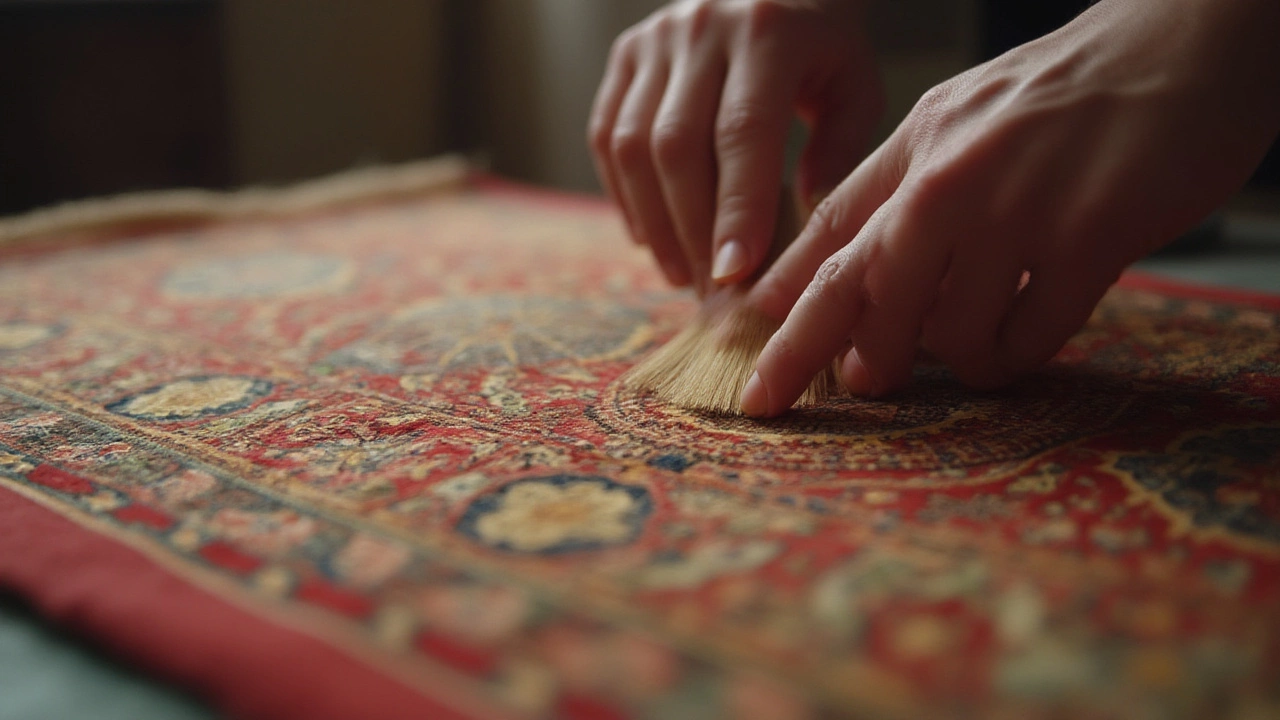What Do Muslims Call the Prayer Rug? Meaning, History, and Everyday Uses

Ever seen someone carefully unrolling a small rug on the floor before bowing their head and whispering a soft prayer? That uniquely patterned, often beautiful piece of fabric isn't just any rug—it's a symbol of faith, tradition, and daily discipline in many Muslim homes around the world. You might have spotted these in airports, parks, or tucked into luggage during long journeys. But what’s it actually called? And why does a simple rug carry so much meaning?
The Name and Meaning of the Muslim Prayer Rug
You’ll often hear Muslims call this special rug a “sajjadah.” This word comes from Arabic, connected to the verb “sajada,” meaning “to prostrate” or “to bow down.” That hints at its deep purpose right away; it’s not just for comfort—it’s about honoring the ritual of prayer (salat), which involves kneeling and touching one’s forehead to the ground.
In lots of countries, locals use different words. In Turkey, people say “seccade.” In Persian-speaking Iran, it's known as “ja-namaz,” literally “place of prayer.” But if you ask almost anyone in the Muslim-majority world, “Where’s your sajjadah?” they’ll know what you mean. Non-Muslims sometimes call it a “prayer mat” or “Islamic prayer rug,” but to those who use it, “sajjadah” carries more personal weight.
This isn't just about labeling a household item—language matters because it reflects beliefs. The very act of naming the rug for its role in prostration ties it to the big idea in Islam: bowing your heart and body before God. The word “sajjadah” isn’t thrown around for just any rug; it’s reserved for this act of devotion.
Even though there’s some variety in what the rug is called, the purpose unites every term. It’s a portable, sacred space. For most Muslims, this rug is the site of their most intimate spiritual moments—at home, on the go, or traveling. Many keep a dedicated, clean space in their home just for laying out the sajjadah. Some even travel with foldable, lightweight versions meant for airports or roadside stops. The sajjadah pops up everywhere from bustling cities like Istanbul and Jakarta to tiny villages across North Africa.
History and Symbolism: More Than Just a Rug
The history of the prayer rug isn’t just dry dates and museum pieces. It’s a living tradition—a story you quite literally kneel on. The earliest sajjadahs weren’t what you find in your local Islamic goods store today. Muslims back in the day simply used clean ground, a piece of cloth, or animal skins. The shift to special woven rugs happened gradually, as Islam spread and local artisans put their own spin on this piece of daily life.
Persian and Anatolian weavers famously started crafting ornate sajjadahs, sometimes going all out with rich colors, intricate geometric patterns, and lush textures. If you look closely, you’ll probably see a niche-shaped design on most rugs, called a “mihrab.” Turns out, that’s not just for looks. The mihrab pattern mimics the niche found in mosques that points to Mecca, the holy city all Muslims face during prayer. It helps the person orient the rug—and themselves—toward the proper direction. A sajjadah laid out backwards is a quick giveaway of a rookie mistake.
Patterns on a sajjadah often hint at where it was made or what materials were available. Turkish prayer rugs usually show tulips or stylized mosque lamps, while Moroccan versions lean into vivid color and Berber symbols. More than just regional pride, these patterns also dodge imagery of people or animals—Islamic tradition typically avoids those in religious art—to keep the focus on devotion, not distraction.
Owning or gifting a beautiful sajjadah can be a big deal. For many, it’s a cherished gift for important milestones—think weddings, first prayers, or the holy month of Ramadan. Family heirlooms get handed down, accompanying someone through all stages of life. It’s not unusual for a child’s first sajjadah to be kept as a keepsake long after they outgrow it. In many Muslim homes, you’ll spot delicate, embroidered or beaded prayer mats hung on walls, serving as both art and inspiration.

How Muslims Use the Sajjadah in Daily Life
So, how does the sajjadah actually fit into Muslim life? It’s woven into daily routines—sometimes quite literally. Muslims pray five times a day, with each prayer having specific times and rituals. Before starting, there’s always a focus on cleanliness. The rug must be clean, and so must your hands and feet. This isn’t just hygiene; it’s a way of showing respect for what’s about to happen.
First, the rug gets unrolled towards the qiblah, the direction of Mecca. Apps and compasses exist to help find the precise direction, especially handy when traveling. Then, after performing ablution (washing), the person stands on the rug and begins the prayer. During the prayer, the sajjadah is like a boundary, reminding you you’re in a sacred space, even if you’re at work or in a crowded airport.
For most Muslims, packing a sajjadah is as natural as grabbing your keys or wallet before leaving the house. Lightweight, pocket-sized versions have popped up in markets all over—from Jakarta’s busy streets to London’s diaspora neighborhoods. Fancy a prayer on the go? Some sajjadahs even roll up into discreet pouches you can slip into a backpack. If someone’s working a long shift, you might spot their rug stashed in a desk drawer, ready for a quick moment of peace at midday.
There’s also etiquette: never place your sajjadah somewhere dirty, never step on it with shoes, and never use it for anything other than prayer. Messy kids sometimes need a gentle reminder that this isn’t a play mat or a makeshift picnic blanket.
Most people wash their sajjadah by hand or on a gentle machine cycle, keeping it as spotless as possible. Having a dedicated drawer or shelf for it is common, so you don’t pull out a wrinkled or grimy rug when it’s time for prayer. If someone visits a Muslim home, they might spot a pile of guest sajjadahs—with slightly simpler designs than ones gifted for special occasions—in case visitors join for communal prayer.
Tips for Buying and Caring for a Prayer Rug
If you’re thinking about buying a sajjadah, whether for personal use or as a thoughtful gift, there are a few things to keep in mind. First off, pick a size that’s right for you. Most are about 2 feet by 4 feet—plenty for the prayer movements, but compact enough to stash away.
Material matters if you’re sensitive to touch or have allergies. Cotton, velvet, and synthetic blends are all easy to find, but nothing beats the classic feel of wool. Still, those can get pricey and tricky to clean. For toddlers or elderly folks, look for mats with extra cushioning to make the kneeling more comfortable.
- Look for a clear, well-marked mihrab design, so you’re not fumbling to figure out which end points towards Mecca.
- Check the quality of stitching, especially if you’ll be rolling and unrolling it a lot.
- If portability is key, opt for lightweight materials and skip heavy tassels or embroidery that can snag.
- Think about aesthetics—does the rug fit with your home’s style, or will it be stored away?
- If you’re gifting, try to match the design or material to the recipient’s preferences—there are sajjadahs out there with everything from minimalist borders to bold, traditional motifs.
To keep your sajjadah in top shape, shake it out daily, spot clean stains, and don’t let it stay damp for long (that could cause it to smell musty). Dedicated cleaning sprays for prayer mats exist, but mild detergent does the trick for most spots. Some people like to iron their mat on low heat, especially if it’s velvety, to keep it looking new.
If you want your rug to last, keep it out of direct sunlight when you’re not using it, as harsh light can fade those intricate colors over time. Some families treat their sajjadah as almost sacred, covering it with a lightweight cloth when not in use. If you end up with an antique handwoven prayer rug, you might even want to get it professionally cleaned and avoid placing it anywhere high-traffic.
There’s actually a surprising market for collectible prayer rugs. Some Turkish or Persian vintage rugs fetch thousands of dollars at auctions—especially if they’re hand-knotted or have a unique design. But whether bought at a bustling bazaar or from a modern online shop, the most important part isn’t price or pattern. The sajjadah’s real value is in the moments of peace, focus, and devotion it brings into everyday life. So next time you spot one, you’ll know it’s called a sajjadah—and you’ll recognize the stories woven into every thread.